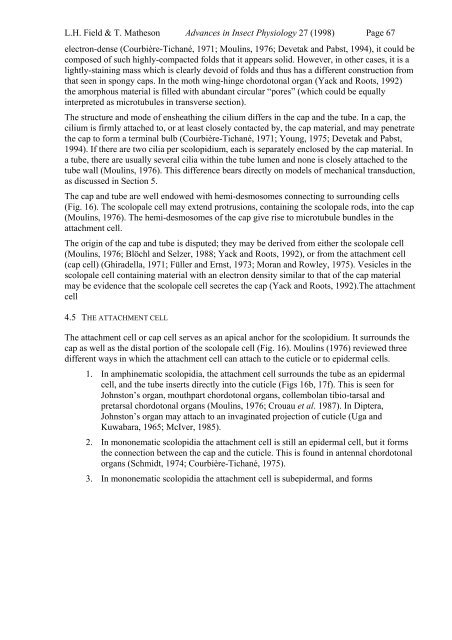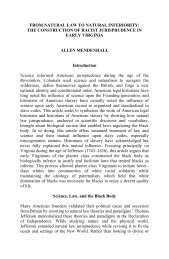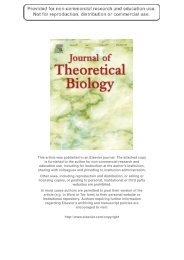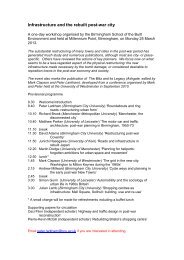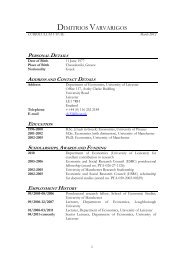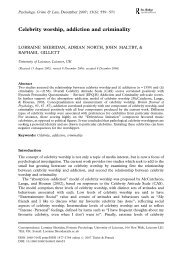Chordotonal Organs of Insects
Chordotonal Organs of Insects
Chordotonal Organs of Insects
Create successful ePaper yourself
Turn your PDF publications into a flip-book with our unique Google optimized e-Paper software.
L.H. Field & T. Matheson Advances in Insect Physiology 27 (1998) Page 67electron-dense (Courbière-Tichané, 1971; Moulins, 1976; Devetak and Pabst, 1994), it could becomposed <strong>of</strong> such highly-compacted folds that it appears solid. However, in other cases, it is alightly-staining mass which is clearly devoid <strong>of</strong> folds and thus has a different construction fromthat seen in spongy caps. In the moth wing-hinge chordotonal organ (Yack and Roots, 1992)the amorphous material is filled with abundant circular “pores” (which could be equallyinterpreted as microtubules in transverse section).The structure and mode <strong>of</strong> ensheathing the cilium differs in the cap and the tube. In a cap, thecilium is firmly attached to, or at least closely contacted by, the cap material, and may penetratethe cap to form a terminal bulb (Courbière-Tichané, 1971; Young, 1975; Devetak and Pabst,1994). If there are two cilia per scolopidium, each is separately enclosed by the cap material. Ina tube, there are usually several cilia within the tube lumen and none is closely attached to thetube wall (Moulins, 1976). This difference bears directly on models <strong>of</strong> mechanical transduction,as discussed in Section 5.The cap and tube are well endowed with hemi-desmosomes connecting to surrounding cells(Fig. 16). The scolopale cell may extend protrusions, containing the scolopale rods, into the cap(Moulins, 1976). The hemi-desmosomes <strong>of</strong> the cap give rise to microtubule bundles in theattachment cell.The origin <strong>of</strong> the cap and tube is disputed; they may be derived from either the scolopale cell(Moulins, 1976; Blöchl and Selzer, 1988; Yack and Roots, 1992), or from the attachment cell(cap cell) (Ghiradella, 1971; Füller and Ernst, 1973; Moran and Rowley, 1975). Vesicles in thescolopale cell containing material with an electron density similar to that <strong>of</strong> the cap materialmay be evidence that the scolopale cell secretes the cap (Yack and Roots, 1992).The attachmentcell4.5 THE ATTACHMENT CELLThe attachment cell or cap cell serves as an apical anchor for the scolopidium. It surrounds thecap as well as the distal portion <strong>of</strong> the scolopale cell (Fig. 16). Moulins (1976) reviewed threedifferent ways in which the attachment cell can attach to the cuticle or to epidermal cells.1. In amphinematic scolopidia, the attachment cell surrounds the tube as an epidermalcell, and the tube inserts directly into the cuticle (Figs 16b, 17f). This is seen forJohnston’s organ, mouthpart chordotonal organs, collembolan tibio-tarsal andpretarsal chordotonal organs (Moulins, 1976; Crouau et al. 1987). In Diptera,Johnston’s organ may attach to an invaginated projection <strong>of</strong> cuticle (Uga andKuwabara, 1965; McIver, 1985).2. In mononematic scolopidia the attachment cell is still an epidermal cell, but it formsthe connection between the cap and the cuticle. This is found in antennal chordotonalorgans (Schmidt, 1974; Courbière-Tichané, 1975).3. In mononematic scolopidia the attachment cell is subepidermal, and forms


